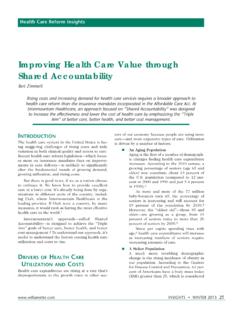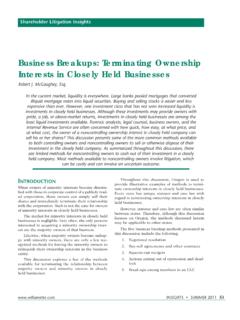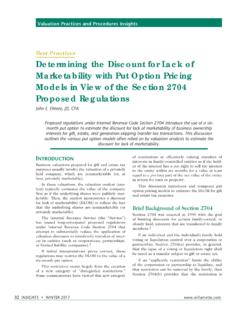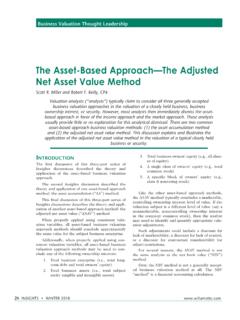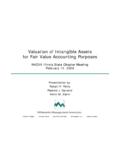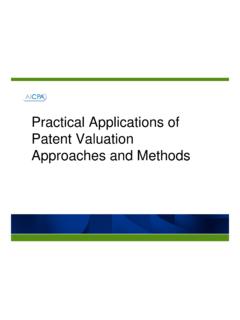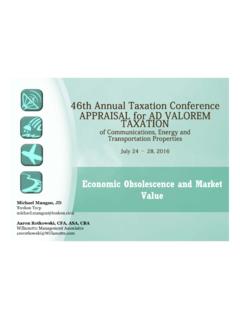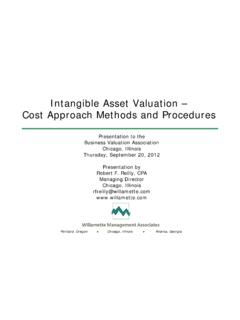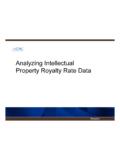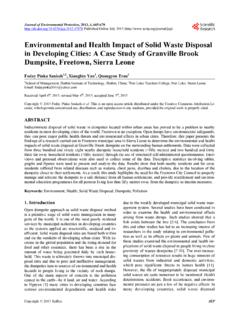Transcription of Intangible Assets in Purchase Price Allocations
1 30 insights summer 2013 www .willamette .comIntangible Assets in Purchase Price AllocationsBrian HollowayTransaction Financial Reporting InsightsThere are numerous reasons why a company will conduct a valuation of its Intangible Assets . One such reason relates to valuing the Intangible Assets , and all other Assets , that were transferred in the acquisition of the company. As is the case with any valuation, the valuation analyst should be familiar with the assignment purpose and with all compliance matters associated with the Intangible asset valuation. This discussion provides an overview of (1) the Purchase Price allocation analysis procedures and (2) the procedures that analysts consider in the valuation of Intangible Assets as part of the acquisition and acquisitions can trigger many financial and tax reporting requirements for companies.
2 A common requirement for both reporting purposes is accounting for an acquisition by providing a pur-chase Price allocation (PPA) PPA is an allocation of the total Purchase Price or total Purchase consideration to the indi-vidual Assets and the individual liabilities included in the acquisitive transaction. A PPA may be per-formed for financial or tax reporting purposes and there are differences to understand and consider with the United States, guidance associated with a PPA for financial reporting purposes is contained in Financial Accounting Standards Board (FASB) Accounting Standards Codification (ASC) topic 805, Business to all transactions that involve a change in control, companies are required to com-plete a PPA for financial reporting purposes regard-less of whether the transaction is structured as an asset Purchase or a stock the United States, International Financial Reporting Standards (IFRS)
3 3R Business Combinations, used by most countries, outlines the accounting for financial reporting purposes when an acquirer obtains control of a business and its underlying Revenue Code Section 1060 and Section 338 provide procedures for completing the PPA in a taxable business Purchase transaction for federal income tax reporting purposes. For federal income tax reporting, companies are only required to com-plete a transaction PPA for:1. an asset Purchase or2. a stock Purchase for which a Section 338 election is made (which accounts for a stock Purchase as if it was an asset pur-chase).A business combination is defined by ASC topic 805 as, a transaction or other event in which an acquirer obtains control of one or more businesses.
4 Transactions sometimes referred to as true mergers or mergers of equals also are business combina-tions. 1A business is defined by ASC topic 805 as, an integrated set of activities and Assets that is capable of being conducted and managed for the purpose of providing a return in the form of dividends, lower costs, or other economic benefits directly to inves-tors or other owners, members, or participants. 2www .willamette .com insights summer 2013 31diFF erences in ppas For Financial reporTing and Tax reporTingDifferences including the computed Purchase Price , standard of value, and valuation procedures and methodology may exist between financial reporting and income tax reporting PPA of Financial Statement ItemsFirst, significant differences may arise in the com-puted Purchase Price paid in a transaction as a result of including or excluding certain transac-tion costs, deferred taxes, and accrued liabilities.
5 Additional differences may arise in the Purchase Price paid as a result of the inclusion and measure-ment of contingent consideration and liabilities and the measurement of assumed debt. The differences above are summarized in Exhibit of ValueSecond, the appropriate standard of value is dif-ferent for PPA valuations performed for financial reporting and tax reporting purposes. For financial reporting purposes, the standard of value is fair value, which is defined by FASB ASC topic 820, Fair Value Measurements and Disclosures, as the Price that would be received to sell an asset or paid to transfer a liability in an orderly transaction between market participants at the measurement date. 3 However, the appropriate standard of value for income tax reporting purposes is fair market value, which is defined by the Revenue Ruling 59-60, as the Price at which property would exchange between a willing buyer and a willing seller, when the former is not under any compulsion to buy and the latter is not under any compulsion to sell, both having reasonable knowledge of the relevant facts.
6 4 The analyst should be aware that there is no single definition of fair market value that is appli-cable for all valuation purposes. In fact, similar, but slightly varied, definitions of fair market value are provided by various statutory authority, judicial precedent, and administrative any event, all of the definitions of fair market value incorporate the concept of the hypothetical and unspecified willing buyer and the hypothetical and unspecified willing seller. In addition to fair value and fair market value, there are other standards of value that exist ( , market value, acquisition value, use value, invest-ment value, owner value, insurable value, and col-lateral value). However, fair value and fair market value are the primary standards of value used in PPAs for financial reporting and income tax report-ing purposes, should be noted that, although there may be specific differences between the fair value and fair market value standards, often the value of an asset valued under these standards will be very similar (however, in some cases the value may be materi-ally different).
7 Valuation ProceduresFinally, differences in the valuation procedures and methods utilized in a PPA may arise in the valuation analyses performed for financial versus tax reporting purposes. Differences include the treatment of bar-gain Purchase transactions, the assignment of good-will and other asset values, and the consideration of the tax amortization benefit for Intangible above-listed differences are summarized in Exhibit requiremenTsExhibit 3 provides a summary of the authoritative literature that is relevant to financial reporting (for Purchase Price Component Financial Reporting Income Tax Reporting Transaction costs Not included Includes certain costs Deferred taxes Included Not included Accrued liabilities Included Partially included Contingent consideration and liabilities Included and measured at fair value if contractual and in certain cases if not contractual Not included Debt measurement Measured at fair value Measured at face value Exhibit 1 Some of the Differences in the Purchase Price Measurement32 insights summer )
8 2013 www .willamette .comboth and outside the ) and income tax reporting (for only the ) for Assets acquired and liabilities assumed as part of a business and liabiliTies included in ppasBusiness combinations involve all classes of tan-gible Assets , Intangible Assets , and liabilities. Per GAAP and tax regulations, acquired Assets and assumed liabilities are not limited to those previ-ously recognized by the business acquired. Certain Assets and liabilities that were not previously recog-nized by the acquired business must be recognized by the acquirer as of the transaction closing. These typically include any Intangible Assets that were internally developed (not previously acquired) by the acquired 4 includes, but is not limited to, the types of tangible Assets , Intangible Assets , and liabilities involved in business combi-nations and Purchase Price Allocations for financial Price Allocations performed for income tax reporting purposes are done under the standard of fair market value.
9 Section 1060 and the regulations under Section 338 further identify the classes of Assets for income tax reporting purposes presented in Exhibit previous discussions were presented to provide a general overview of PPAs, includ-ing information on the reporting require-ments associated with financial reporting and tax reporting and the types of Assets and liabilities that are subject to discussed previously, Assets acquired, liabilities assumed, and other items which are associated with an acquisition, or busi-ness combination, have an impact in a PPA. An allocation should be performed to the acquired Assets and liabilities, whereby these are recorded at fair value as of the acquisition date for financial reporting pur-poses.
10 Topic Financial Reporting Income Tax Reporting Bargain purchases Gain recognized Sequential allocation under residual method Ownership of Assets At the reporting unit level At the legal entity level Goodwill allocation Can allocate to the buyer s preexisting reporting units Only allocated to acquired entities Goodwill assignment of value and impairment Tested at the reporting unit level and assigned at a jurisdictional level Jurisdictional level and no impairment testing requirements Tax amortization benefit for Intangible Assets Always included Included only to the extent amortization is tax deductible Exhibit 2 Differences in the Acquired asset Valuation Approaches and Methods Financial Reporting Requirements: FASB ASC 805, Business Combinations FASB ASC 820, Fair Value Measurements and Disclosures FASB ASC 350, intangibles Goodwill and Other FASB ASC 360, Impairment or Disposal of Long-Lived Assets FASB ASC 852, Reorganizations FASB ASC 740, Accounting for Income Taxes IFRS 3R, Business Combinations IFRS 13, Fair Value Measurement Income Tax Reporting Requirements: IRC Section 1060 IRC Section 338 IRC Section 197 Exhibit 3 Financial Reporting and Income Tax Accounting Requirementswww.

